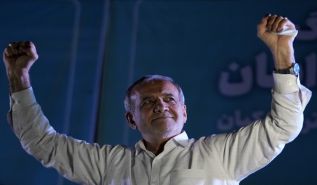بسم الله الرحمن الرحيم
Between Gold and the Dollar
(Translated)
Al-Rayah Newspaper - Issue 571 - 29/10/2025
By: Dr. Muhammad Gilani
On August 15, 1971, under President Nixon, the United States abolished the Bretton Woods Agreement, which fixed the price of gold at $35 per ounce. The primary motivation for this historic decision was the massive increase in dollar amounts issued by the Federal Reserve, particularly the funds allocated by the United States to rescue Europe, known as the Marshall Plan. By 1971, Europe had accumulated an estimated $10-40 billion, equivalent to 11.2-40.8 tons of gold in gold, in accordance with the Bretton Woods Agreement. This exceeded America’s gold reserves, according to 1971 statistics, which were equivalent to 10,000 tons. America had no choice but to abandon its commitment to the Bretton Woods rule, which allowed global central banks to exchange their dollars for gold. Despite Europe’s opposition, particularly France’s, to the US's cancellation of the agreement, the US persisted with its decision and forced Europe to follow this path. This was especially true when it persuaded, or forced, OPEC, led by Saudi Arabia, to replace the gold-dollar standard with the oil-dollar standard, known as the petrodollar.
When examining the relationship between the dollar and oil, and the relationship between the dollar and gold, we find a major dilemma facing the US-controlled monetary system. After the dollar escaped the shackles of gold, and subsequently the shackles of economic growth that Reagan worked to undo during his term in office (1980-1988), the US allowed the issuance of massive amounts of dollars, exceeding its gold or commodities in circulation in local and global markets.
These amounts of dollars reached very large quantities in the global market. The available money in the form of real cash (M0) amounts to $8.3 trillion, and the amount of dollars circulating through bank checks (M1) equals $56.7 trillion. If bank savings accounts (M3) are added to this, the global amount of dollars becomes $123 trillion. However, the EBC Financial Group estimates the value of dollars worldwide at $471 trillion. This means that the amount of money measured in dollars could exhaust all the available gold in the world, whether it has been produced or not. According to the US Geological Survey, the amount of gold discovered worldwide is estimated at 244,000 tons, in addition to the 50,000 tons estimated to be underground. If the amount of discovered gold is considered to be 300,000 tons, this means that the available dollars issued by the Federal Reserve, or that it could use, would be enough to buy all the gold in the world at the current price for less than 7% of the amount of dollars available in the world.
It’s true that gold is not the basis for monetary policy, and the conversion of dollars into gold is not imposed on countries. However, the only thing the United States guaranteed after its abolition of the Bretton Woods Agreement was the stability of the exchange rate between gold and the dollar. This is where the danger of a massive accumulation of dollars, enough to buy all the world’s gold 15 times over, lies.
On the other hand, what is known as inflation, refers to a significant increase in the amount of money in circulation, or tradable, compared to the available goods that can be purchased with the available cash. While inflation can be measured by the availability of consumables such as food, utilizable goods such as machinery, or strategic goods such as weapons, gold remains the most important indicator of inflation, especially if it becomes highly sought after for investment or storage. If we consider the quantity and value of assets used by people worldwide, distributed among food, medicine, military, aerospace, and complementary industries, including gold, it reached approximately $40 trillion in 2023 and $64 trillion in 2024. If we compare this value with the circulating currency alone, which amounts to $160 trillion, we realize the seriousness of the global financial situation. Here, we must note the significant increase in the value of traded goods between 2023 and 2024, which reached $4 trillion. This alarming increase is primarily due to an increase in the prices of goods, consumables, and strategic materials, not necessarily an increase in consumption.
The prominent and noticeable trend today in gold prices is because gold is the commodity whose price can be significantly increased without creating global chaos. Instead of significantly raising interest rates to curb inflation, and a significant increase in the price of consumable goods, attention is turning to gold as a safe haven, as its price increases do not affect people’s lives. Instead, the rise in gold’s price is viewed as an investment opportunity, not a manifestation of the inflation that afflicts most of the world's population.
In fact, the fundamental issue around which the issues of rising prices, whether of gold or other commodities, revolve is a natural consequence of the fundamental issue of the process of issuing fiat money. For centuries, the world has lived financially with a single currency, gold or its equivalent, in circulating currency. This system can never suffer from inflation. On the contrary, increased production always leads to a natural decrease in prices. This is in contrast to the capitalist system, the financial component of which was imposed by America.
The question remains: Is it possible to return to the gold standard, where gold becomes the global currency and all efforts and funds are valued in gold and silver, for instance? The answer relates not only to the financial system, but to the economic system as a whole, and to the political system that can make economic decisions regardless of the positions of other countries. This is easier said than done, as it is a decision that provokes the world’s leading power, America, which considers the separation of gold from any monetary base, one of the foundations upon which it relies to achieve great global dominance. We have seen how Europe, the land most capable of confronting America, at least perhaps 75 years ago, when it abolished the gold standard, was unable to stand up to America. Similarly, the Soviet Union found no way to challenge America’s decision, and was content with purchasing foreign currencies with real gold, to purchase goods from various countries around the world, even though it significantly reduced its imports of global goods.
To this day, the emergence of organizations such as BRICS and the Shanghai Cooperation Organization (SCO) speak with great caution about the global monetary system. However, all they discuss is intra-regional trade between members of these organizations, using their own currency. Their strategy falls far short of issuing a currency based on gold.
America has succeeded in making monetary policy and the dominance of the dollar a strategic issue in its dealings with the world. Any deviation from this could have very serious consequences. The world’s most powerful countries are fully aware of this and are working diligently to avoid provoking it.
Hence, challenging the global monetary system must be part of challenging the global system as a whole, whether on the intellectual, ideological, economic, and financial levels. Their strategy falls far short of issuing a gold-based currency. This can only be achieved in the Khilafah (Caliphate) State, which possesses a political and economic system based on enlightened thought, and controls the most important natural resources such as gas, oil, and minerals, as well as the world’s most important waterways. This is in addition to its enormous human potential. The Khilafah, which will soon emerge, InshaAllah, and is the only state capable of offering the entire world a financial system coupled with an economic, political, and humanitarian system based on an ideological thought that is not based on self-interest, whether immediate or future.




